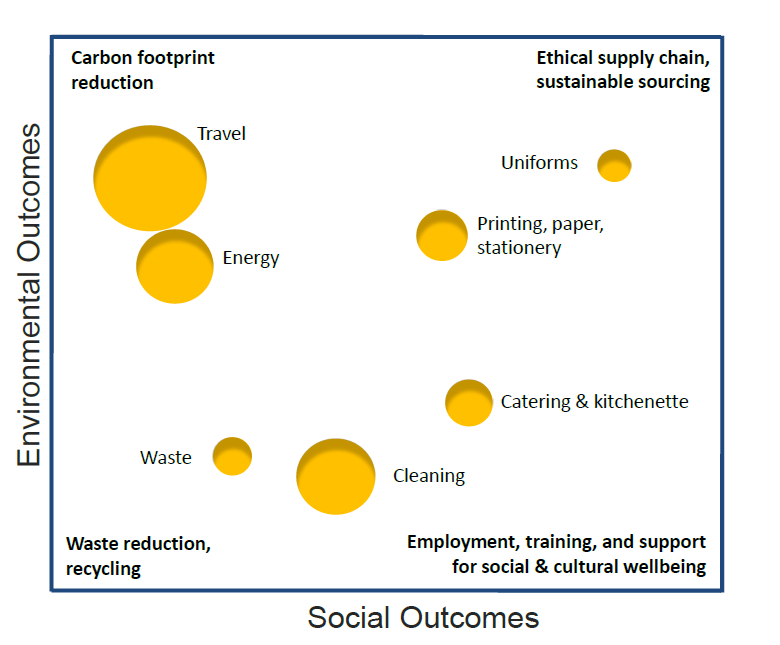Inland Revenue’s roadmap to greater public value through better buying.
Inland Revenue’s Commercial and Procurement team has developed a social procurement strategy to help achieve better outcomes from every dollar they spend. This case study shows how broader outcomes can work in practice.
The Commercial and Procurement team designed their social procurement strategy with Inland Revenue’s strategic mission in mind – to contribute positively to the economic and social wellbeing of New Zealand. “It’s about spending the same dollar twice. We’d like to think we can extend the use of each dollar we spend on goods and services to also generate social outcomes,” says Juliet Glass, the team’s Manager, and Acting Head of Commercial and Procurement.
The team’s strategy has three focus areas for social procurement:
The team got executive endorsement for their new approach and presented the strategy to key stakeholders across the organisation. The new approach is filtering through the organisation. “Our people are starting the conversation. They’re starting to think differently about their buying activity and challenging the status quo. It’s an easy sell. Why wouldn’t we use our relationships and influence to generate better buying outcomes?” says Juliet.
Our roadmap for delivering the strategy is simple. Establish the current state, realise opportunities through existing arrangements, remove barriers to participation, and create new opportunities through our procurement activity.
Juliet Glass Manager, and Acting Head of Commercial and Procurement, Inland Revenue
Social procurement is another name for broader outcomes. When you use the way you buy to achieve secondary outcomes beyond the immediate purchase of the goods, services and works, it’s called social or sustainable procurement. In the Government Procurement Rules this is referred to as incorporating broader outcomes. A social procurement strategy helps to incorporate broader outcomes.
The team used an opportunities analysis (Figure 2) to identify categories where social and environmental outcomes could be achieved through existing and new arrangements.
“When looking for opportunities we found that even offering what we might consider to be relatively small amounts of work made a difference – there’s a ripple effect from everything you do. It doesn’t matter if the contract isn’t up for renewal, we’ll still have the conversation with the supplier because it’s the right thing to do,” says Karen Whitehouse, Manager Commercial Corporate.

“We shared our strategy and aspirations with our key suppliers and started the conversation on social procurement. They were genuinely delighted to be talking about something different and to help us upskill! We found several key suppliers had already established programmes delivering social outcomes." “We uncovered some of the ‘accidental’ social procurement already happening and are exploring opportunities to work with social enterprises and co-design initiatives. Our supplier relationship management programme has been a key enabler and we are able to build on our existing relationships with suppliers. Social procurement is also discussed at some of our monthly account meetings with key suppliers,” says Juliet.
The team engaged the Ākina Foundation to help them co-design a theory of change around creating sustainable employment for disadvantaged job seekers and to run a workshop with suppliers. The workshop got suppliers thinking differently about what was possible and they took the conversations back into their organisations. One of the suppliers has since set up a social enterprise to meet a market need, with another wanting to connect into it.
The team are thinking about how they can use their social procurement approach to help achieve the priority outcomes outlined in the Government Procurement Rules. These are the broader outcomes the Government has prioritised for agencies to focus on.
“Increasing access for New Zealand businesses is a priority outcome for Government. We want social enterprises participating directly and indirectly in our supply chain to help deliver on this outcome,” says Juliet. The platform connects organisations (buyers) to social enterprises capable of delivering goods and services (suppliers). The team plans to use the platform as part of their market research activities.
By the end of the year, Inland Revenue hopes to have at least four social enterprises participating in their supply chain and another six by the end of 2020. They are also working on how they will report on social outcomes being delivered through their supply chain.
Government procurement can be used to support wider cultural, social, economic and environmental outcomes that go beyond the immediate purchase of goods and services. Together these outcomes are called broader outcomes. The Government’s new policy on achieving them is set out in the recently revised Government Procurement Rules.
This case study has been published to encourage and inspire government agencies, as they begin to implement the new broader outcomes Rules, with a particular focus on the government’s priority outcomes.
The priority outcome this case study aligns with:
It also is an example of: